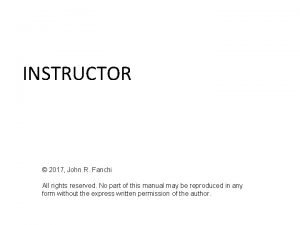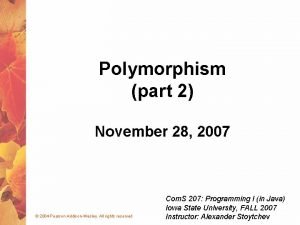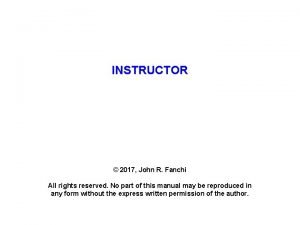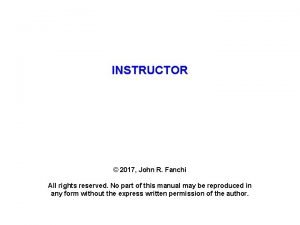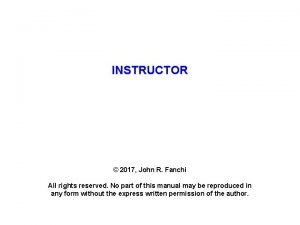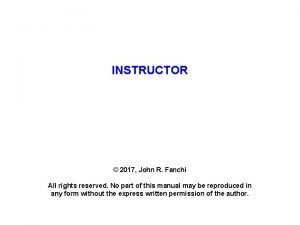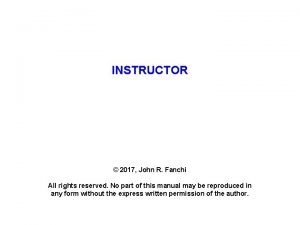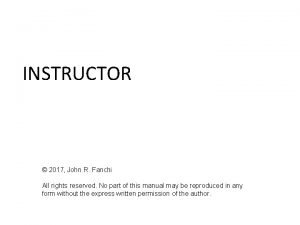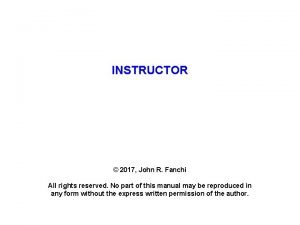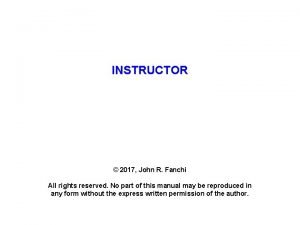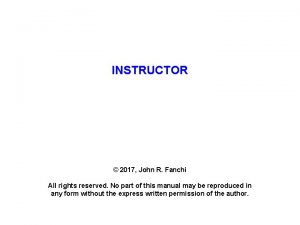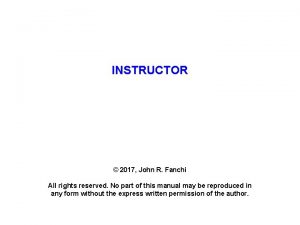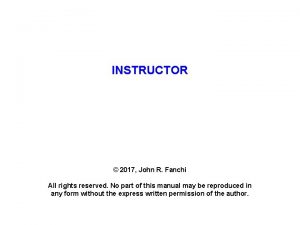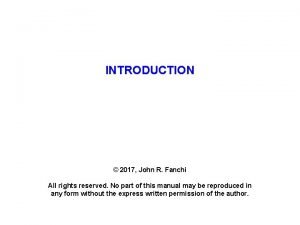INSTRUCTOR 2017 John R Fanchi All rights reserved























































![Principal Applications of Common Well Logs (after Selley and Sonnenberg [2015, page 86]) Log Principal Applications of Common Well Logs (after Selley and Sonnenberg [2015, page 86]) Log](https://slidetodoc.com/presentation_image/7db1aa7c072d01a51f4e735c1d3c1ed8/image-56.jpg)




- Slides: 60

INSTRUCTOR © 2017, John R. Fanchi All rights reserved. No part of this manual may be reproduced in any form without the express written permission of the author.

To the Instructor The set of files here are designed to help you prepare lectures for your own course using the text Introduction to Petroleum Engineering, J. R. Fanchi and R. L. Christiansen (Wiley, 2017) File format is kept simple so that you can customize the files with relative ease using your own style. You will need to supplement the files to complete the presentation topics.

WELL LOGGING © 2017, John R. Fanchi All rights reserved. No part of this manual may be reproduced in any form without the express written permission of the author.

Outline Ø Well Logging Ø Subsurface Ionic Environment Ø Lithology Logs Ø Porosity Logs Ø Resistivity Logs Ø Induction Logs Ø Log Calibration with Formation Samples Ø Modern Log Applications Homework: IPE Ch. 9

WELL LOGGING

Well Logging Objectives Ø Estimate near wellbore formation properties Ø Ø Ø Ø Depth Thickness (net and gross) Porosity Formation density Acoustic velocity Temperature and pressure Lithology (rock type) Fluid saturations Ø Indication of hydrocarbons Ø Indicate permeability (e. g. high, low, tight) Ø Structural trends (e. g. formation dip) Ø Fracture properties

Typical Applications of Well Logs Ø Quality of wellbore Ø Size of wellbore (caliper log) Ø Integrity of cement bond (cement bond log) Ø Provide information for Ø Geologic mapping Ø Prospect evaluation (where to drill) Ø Reserve estimates Ø Indicate presence of hydrocarbons Ø Measure Sw; infer hydrocarbons Ø Fluid contacts, e. g. GOC, WOC Ø Indicate which zones to complete (perforate)

Well Log Header and Tracks Header Scale Track 1 Track 2 3 Depth Track Scale

Well Log Schematic Well Data Logging Data Track 1 Res Depth Track SP Track 2

Types of Well Logs Ø Lithology logs Ø Spontaneous Potential (SP) Ø Now tends to be replace by Gamma Ray Ø Gamma Ray (GR) Ø Photoelectric Effect (PEF) Ø Porosity logs Ø Density Ø Neutron Ø Acoustic (Sonic) Ø Resistivity logs Ø Induction Ø Laterolog Ø Micro Resistivity Ø Specialty Logs Ø e. g. FMI (Formation Micro Image)

Computer Generated Logs Ø Computer performs corrections and calculations Ø Graphical view Ø Easy to see analysis Ø Estimate lithology, saturations, porosity, etc.

SUBSURFACE IONIC ENVIRONMENT

Ohm’s Law: V = IR where V = voltage (volts) I = current (amps) R = resistance (ohms) Conductance = 1/R (Siemens) 1 Siemens = 1 mho = 1/ohm Electrical current is charge in motion, e. g. Na+ cation and Cl anion.

Alternative form of Ohm’s Law: E = ρJ where E = electric field (volt/m) J = current density (amp/m 2) ρ = resistivity (ohm m) L A + − Ø Carrier of positive charge moves in direction of E, I, J Ø Carrier of negative charge (e ) moves in opposite direction

Resistivity and Resistance Resistivity is related to resistance. For uniform conductor with length L and area A: R = ρ L / A Resistivity ρ is the inverse of conductivity σ : ρ = 1 / σ Alternative form of Ohm’s Law: E = ρJ where E = electric field (volt/m) J = current density (amp/m 2) ρ = resistivity (ohm m) L A + −

Fluids that Affect Logging Measurements Ø Ø Drilling mud (resistivity Rm) Mud filtrate(resistivity Rmf) Formation water(resistivity Rw) Hydrocarbons (assumed infinite resistivity) Resistivity depends on formation temperature

Invasion Zones for Drilling Fluids Uninvaded Zone Borehole Uninvaded Zone Adjacent Bed Mud Cake Flushed Zone of Transition

LITHOLOGY LOGS

Common Reservoir Rock Types and an Illustrative Stratigraphic Column

Gamma Ray Log or Natural Gamma Ray Log Ø Gamma rays (GR) from NORM Ø Measure in API units Ø Relative unit Ø NORM Ø Potassium Ø GR energy 1. 46 Me. V Ø Thorium series Ø GR energy 2. 62 Me. V Ø Uranium Radium series Ø GR energy 1. 76 Me. V

Light Matter Interaction Photoelectric Effect Time Ø Low energy phenomenon Ø Photoelectric effect Ø Mid energy phenomena Ø Thomson scattering (elastic) Ø Compton scattering (inelastic) Ø High energy phenomenon Ø Pair production Space Compton Scattering Photon wavelength changes

Gamma Ray Log Response

NORM in West Texas Barnett Shale Ø Mississippian Barnett Shale above MD = 9606 ft Ø Mississippian Limestone below MD = 9606 ft Ø SGR – Spectral Gamma Ray Ø CGR – Total GR minus URAN Ø POTA – Potassium 40, wt % Ø URAN – Uranium, ppm Ø THOR – Thorium, ppm Barnett Shale Limestone Source: Asquith and Krygowski, Fig. 3. 3, Basic Well Log Analysis, 2 nd Ed (2004)

Lithology Log: Gamma Ray LOG Gamma Ray VARIABLE Rock Type RESPONSE Detects shale from in situ radioactivity. High GR shales Low GR clean sands and carbonates Ø In most cases, shale formations are most radioactive Ø Most reservoir rocks exhibit low radioactivity Ø GR log is shale indicator

SP (Spontaneous Potential) Ø SP = Potential difference (voltage) between 2 fluids with different salinities Ø SP electrode Ø Grounded on surface Ø Connected to logging tool Ø SP affected by shale content Ø Can calculate formation water resistivity RW from SP Ø Need RW to calculate saturation

SP (aka Self Potential) Log Ø Measures potential difference between drilling fluids and formation waters Ø Distinguish permeable beds from shale Ø Small SP response impermeable shale Ø Large SP response permeable beds Ø SP log hard to interpret when formation waters are fresh (not salty)

Lithology Log: Spontaneous Potential LOG VARIABLE Spontaneous Permeable Potential Beds RESPONSE Measures electrical potential (voltage) associated with movement of ions. Low response impermeable shale Large response permeable beds

Lithology Log: Photoelectric Effect LOG VARIABLE Photoelectric Rock Type Effect RESPONSE Measure absorption of low energy gamma rays by atoms in formation. High GR shales Low GR clean sands and carbonates (absorb GR) Ø Photoelectric effect log is shale indicator Photoelectric Effect

POROSITY LOGS Formation Density Neutron Porosity Sonic

Density Log Ø Gives rock density reading in gm/cc Ø Ø Water = 1 gm/cc (62. 4 lb/cu ft or 8. 33 ppg) Sandstone ~ 2. 65 gm/cc Limestone ~ 2. 71 gm/cc Salt ~ 1. 6 – 2. 0 gm/cc Ø Calculate porosity % from log reading and rock type

Estimate Porosity from Density given Lithology

Porosity Log: Density LOG Density VARIABLE Porosity* RESPONSE Measures electron density by detecting Compton scattered gamma rays. Electron density is related to formation density. Good for detecting hydrocarbon gas with low density compared to rock or liquid. Low response low HC gas content Large response high HC gas content * The combination of density log and neutron log provides the most reliable porosity estimate and can be used to indicate gas. Ø Shale reduces apparent porosity measured by density log Ø Gas increases apparent porosity measured by density log

Porosity Log: Neutron LOG Neutron VARIABLE Hydrogen Content RESPONSE Fast neutrons are slowed by collisions to thermal energies. Thermal neutrons are captured by nuclei, which then emit detectable gamma rays. Note: hydrogen has a large capture cross section for thermal neutrons. Good for detecting gas. Large response high H content Small response low H content Ø Shale appears as high apparent porosity measured by neutron log Ø Dry gas appears as low apparent porosity measured by neutron log

Neutron – Density Crossplot Ø Neutron – Density crossplot Ø plot porosity from neutron log vs porosity from density log 1. 0 density Gas sand density > neutron Clean sand line density = neutron Shaly sand density < neutron 0. 0 neutron 1. 0

Neutron Log – Density Log Comparisons Ø Gas indicator Ø Crossplot can identify gas bearing sands in sand shale sequences Ø Lithology indicator Ø Apparent limestone porosity will appear high in density log if limestone contains anhydrite

Gas Effect Density Neutron Crossover Ø How do logs respond when gas is present? Ø Density log reads porosity correctly Ø Neutron log treats gas as rock so it reads low porosity Ø Therefore curves separate when gas is present Ø Gas probably present when density log and neutron log separate

Typical Sonic Log Velocities Velocity (ft/sec) t ( second/ft) Shale 7, 000 – 17, 000 144 – 59 Sandstone 11, 500 – 16, 000 87 – 62 Limestone 13, 000 – 18, 500 77 – 54 Dolomite 15, 000 – 20, 000 67 – 50 Natural Gas 1, 500 667 Water 5, 000 200

Porosity Log: Sonic LOG VARIABLE Acoustic Porosity (sonic) RESPONSE Measures speed of sound in medium. Speed of sound faster in rock than in fluid. Long travel time slow speed large pore space Short travel time high speed small pore space Ø Porous rock slows down sound waves Ø Porosities calculated from sonic log measurements are generally high in hydrocarbon bearing unconsolidated sands

RESISTIVITY LOGS

Gamma Ray and Resistivity Logs Short Long Gamma Ray Log Resistivity Log

INDUCTION LOGS

What is induction logging? Ø Based on Faraday’s law of electromagnetic induction Ø Oscillating magnetic field induces electric field Ø Transmitter coil in tool creates primary magnetic field Ø Primary magnetic field induces toroidal electric field Ø Toroid = doughnut shape

What is induction logging? (cont. ) ØToroidal electric field creates electrical “eddy current” Ø Eddy current is induced in conductor by changing magnetic field Ø Strength of eddy currents depends on conductivity Ø Eddy currents create secondary magnetic field Ø Measure secondary magnetic field with receiver coil

What is induction logging? (cont. ) Transmitter coil Primary magnetic field Eddy current in conductor (e. g. ionic environment) Secondary magnetic field Receiver coil

SI Unit of Conductivity Ø Conductivity is inverse of resistivity Ø Conductivity unit is siemens/meter (S/m) or millisiemens/meter (m. S/m) Ø where 1 Siemen = 1 mho = 1/ohm Ø Common conductivity unit is micromho/cm Ø 1 micromho/cm = 1 μS/cm. Ø Convert to logged units using 10 μS/cm = 1 m. S/m Ø Example Ø suppose resistivity is 10 ohm m Ø conductivity = 1/(10 ohm m) = 0. 1 mho/m = 0. 1 S/m

Electrode Log or Dual Laterolog LOG Electrode or Dual Laterolog VARIABLE Fluid Type RESPONSE Measures resistivity of formation water. High resistivity hydrocarbons Low resistivity brine

Resistivity Logs and Borehole Fluids Log Need Conductive Borehole Fluid? Comment(s) Induction No Work with oil based mud and air filled boreholes. Unreliable in boreholes filled with very conductive mud. Dual laterolog* Yes Will not work with oil based mud and air filled boreholes *Laterolog tools use electrodes to measure formation resistivity (shallow and deep) through saline borehole fluids

Dual Laterolog Curves Distinguish between Water Bearing Zone and Hydrocarbon Bearing Zone Log Measures GR Gamma Ray CALI Caliper LLD Deep Laterolog True formation resistivity (Rt) LLS Shallow Laterolog Resistivity of invaded zone (Ri) RXO Microresistivity Resistivity of flushed zone MSFL Microspherically focused Resistivity of flushed zone Source: Asquith and Krygowski, Figs. 1. 7 & 1. 9, Basic Well Log Analysis, 2 nd Ed (2004)

Activity Well Log Responses – 1 Place the correct answer in the left hand column. Log Gamma Ray 1 Density Photoelectric Effect Electrode (dual laterolog) 2 3 Acoustic (sonic) SP 5 6 Neutron 7 8 4 Response Measures electrical potential (voltage) associated with movement of ions. Detects shale from in situ radioactivity. Measures speed of sound in medium. Speed of sound faster in rock than in fluid. Fast neutrons are slowed by collisions to thermal energies. Thermal neutrons are captured by nuclei, which then emit detectable gamma rays. Measures resistivity of formation water. Measure absorption of low energy gamma rays by atoms in formation. Measures electron density by detecting Compton scattered gamma rays. None of the above

Activity Well Log Responses – 2 Place the correct answer in the left hand column. There may be some duplication. Log Neutron SP Density Photoelectric Effect Acoustic (sonic) Electrode (dual laterolog) Gamma Ray 1 2 3 4 5 6 Identifies Porosity Fluid Type Rock Type Hydrogen content Permeable beds None of the Above

LOG CALIBRATION WITH FORMATION SAMPLES

Mud Log Ø ROP Ø Rate of Penetration Ø Gamma rays (GR) from NORM Ø Measure in API units Ø Relative unit Ø Potassium Ø GR energy 1. 46 Me. V Ø Thorium series Ø GR energy 2. 62 Me. V Ø Uranium Radium series Ø GR energy 1. 76 Me. V

NORM in West Texas Barnett Shale Ø Mississippian Barnett Shale above MD = 9606 ft Ø Mississippian Limestone below MD = 9606 ft Ø SGR – Spectral Gamma Ray Ø CGR – Total GR minus URAN Ø POTA – Potassium 40, wt % Ø URAN – Uranium, ppm Ø THOR – Thorium, ppm Barnett Shale Limestone Source: Asquith and Krygowski, Fig. 3. 3, Basic Well Log Analysis, 2 nd Ed (2004)

Evaluate Well Cuttings Ø Well Site Geologist Ø Examines Well Cuttings Ø Makes note of cores Ø Full Diameter Cores Ø Side Cores

MODERN LOG APPLICATIONS
![Principal Applications of Common Well Logs after Selley and Sonnenberg 2015 page 86 Log Principal Applications of Common Well Logs (after Selley and Sonnenberg [2015, page 86]) Log](https://slidetodoc.com/presentation_image/7db1aa7c072d01a51f4e735c1d3c1ed8/image-56.jpg)
Principal Applications of Common Well Logs (after Selley and Sonnenberg [2015, page 86]) Log Type Lithology Hydrocarbons Porosity Pressure ELECTRIC Dip SP X Resistivity X X X Gamma Ray X Neutron X X Density X X SONIC X X DIPMETER X RADIO ACTIVE

Illustration of a Fence Diagram (A) A clean sand interval indicated by gamma ray (GR) logs. (B) Fence diagram displaying clean sand correlation.

Interpret Depositional Environment Using Well Logs Typical electrical log shapes… Resistivity S. P. Shale Sandstone Interbedded SS & Shales Shale Well Sandstone Shale Well for beach or barrier island marine SS for fluvial SS *Fig. 158, P. K. Link, Basic Petroleum Geology, 3 rd Edition (2001), Tulsa: OGCI

QUESTIONS?

SUPPLEMENT
 Gssllc
Gssllc All rights reserved example
All rights reserved example Copyright 2015 all rights reserved
Copyright 2015 all rights reserved All rights reserved sentence
All rights reserved sentence Freesound content licence
Freesound content licence Confidential all rights reserved
Confidential all rights reserved Sentinel controlled repetition
Sentinel controlled repetition Copyright © 2015 all rights reserved
Copyright © 2015 all rights reserved Pearson education inc all rights reserved
Pearson education inc all rights reserved Microsoft corporation. all rights reserved.
Microsoft corporation. all rights reserved. Microsoft corporation. all rights reserved.
Microsoft corporation. all rights reserved. Microsoft corporation. all rights reserved
Microsoft corporation. all rights reserved Pearson education inc. all rights reserved
Pearson education inc. all rights reserved Dell all rights reserved copyright 2009
Dell all rights reserved copyright 2009 Warning all rights reserved
Warning all rights reserved All rights reserved c
All rights reserved c All rights reserved formula
All rights reserved formula Warning all rights reserved
Warning all rights reserved Confidential all rights reserved
Confidential all rights reserved Microsoft corporation. all rights reserved
Microsoft corporation. all rights reserved Pearson education inc. all rights reserved
Pearson education inc. all rights reserved Copyright © 2018 all rights reserved
Copyright © 2018 all rights reserved Pearson education inc all rights reserved
Pearson education inc all rights reserved 2010 pearson education inc
2010 pearson education inc Confidential all rights reserved
Confidential all rights reserved Confidential all rights reserved
Confidential all rights reserved R rights reserved
R rights reserved Rights reserved
Rights reserved Positive vs negative rights
Positive vs negative rights Litoral rights
Litoral rights Characteristics of rights
Characteristics of rights Legal rights vs moral rights
Legal rights vs moral rights Negative rights vs positive rights
Negative rights vs positive rights Negative rights
Negative rights Negative right
Negative right Negative right
Negative right Name 3 points
Name 3 points Tipos de participantes en una capacitación
Tipos de participantes en una capacitación Tcole instructor course
Tcole instructor course Basic instructor course texas
Basic instructor course texas Basic instructor course #1014
Basic instructor course #1014 Pepperball training manual
Pepperball training manual Neither of my two suitcases are adequate for this trip
Neither of my two suitcases are adequate for this trip Instructor vs teacher
Instructor vs teacher Cisco certified trainer
Cisco certified trainer Mptc instructor
Mptc instructor Basic instructor course texas
Basic instructor course texas Basic instructor course texas
Basic instructor course texas Virtual instructor.com
Virtual instructor.com Nfpa 1403
Nfpa 1403 Human factors instructor
Human factors instructor Instructor operating station
Instructor operating station Catia instructor
Catia instructor Instructor
Instructor Instructor responsibilities and professionalism
Instructor responsibilities and professionalism Tcole 1014 basic instructor course
Tcole 1014 basic instructor course Usmc jrotc vacancies
Usmc jrotc vacancies How to become an nrp instructor mentor
How to become an nrp instructor mentor Cisco instructor certification
Cisco instructor certification Cbrf registry wi
Cbrf registry wi Nra certified instructor logo
Nra certified instructor logo


























